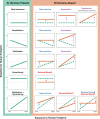The influence of human presence and footprint on animal space use in US national parks
- PMID: 40742992
- PMCID: PMC12312893
- DOI: 10.1098/rspb.2025.1013
The influence of human presence and footprint on animal space use in US national parks
Abstract
Given the importance of protected areas for biodiversity, the growth of visitation to many areas has raised concerns about the effects of humans on wildlife. In 2020, the COVID-19 pandemic led to temporary closure of national parks in the United States, offering a pseudonatural experiment to tease apart the effects of permanent infrastructure and transient human presence on animals. We compiled GPS tracking data from 229 individuals of 10 mammal species in 14 parks and used third-order hierarchical resource selection functions to evaluate the influence of the human footprint on animal space use in 2019 and 2020. Averaged across all parks and species, animals avoided the human footprint, whether the park was open or closed. However, although animals in remote areas showed consistent avoidance, on average those in more developed areas switched from avoidance to selection when protected areas were closed. Findings varied across species: some responded consistently negatively to the footprint (wolves, mountain goats), some positively (mule deer, red fox) and others had a strong exposure-mediated response (elk, mountain lion). Furthermore, some species responded more strongly to the park closure (black bear, moose). This study advances our understanding of complex interactions between recreation and wildlife in protected areas.
Keywords: Resource Selection Function; animal movement; functional response; human footprint; human-wildlife interactions; protected areas; recreation.
Conflict of interest statement
We declare we have no competing interests.
Figures






References
-
- Pacifici M, Marco MD, Watson JEM. 2020. Protected areas are now the last strongholds for many imperiled mammal species. Conserv. Lett. 13, e12748. ( 10.1111/conl.12748) - DOI
MeSH terms
Grants and funding
- National Center for Ecological Analysis and Synthesis
- Sportsmen for Fish and Wildlife
- Directorate for Biological Sciences
- Nevada Department of Transportation
- Ministry of Natural Resources
- Michigan Department of Natural Resources
- International Wolf Center
- National Parks of Lake Superior Foundation
- Yellowstone Forever
- Grand Portage Band of Lake Superior Chippewa
- Grand Teton Association
- Grand Teton National Park Foundation
- University of Minnesota
- California Department of Fish and Wildlife
- Yosemite Conservancy
- Detroit Zoological Society
- Michigan Technological University
- Minnesota Environment and Natural Resources Trust Fund
- National Park Service
- Utah Division of Wildlife Resources
- Arizona Game and Fish Department
- Utah Wild Sheep Foundation
- Safari Club International
- Natural Sciences and Engineering Research Council of Canada
- Zion Forever Project
- National Institute of Food and Agriculture
- Federal Aid in Wildlife Restoration
- Grand Canyon Conservancy
LinkOut - more resources
Full Text Sources
Other Literature Sources
